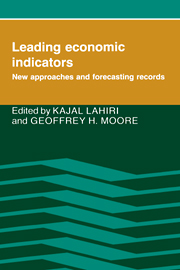Book contents
- Frontmatter
- Contents
- Preface
- List of contributors
- 1 Introduction
- PART I NEW CONCEPTS AND METHODS
- 2 Toward a theory of leading indicators
- 3 A time-series framework for the study of leading indicators
- 4 A probability model of the coincident economic indicators
- 5 An international application of Neftci's probability approach for signaling growth recessions and recoveries using turning point indicators
- 6 On predicting the stage of the business cycle
- 7 Bayesian methods for forecasting turning points in economic time-series: Sensitivity of forecasts to asymmetry of loss structures
- 8 New developments in leading indicators
- PART II FORECASTING RECORDS AND METHODS OF EVALUATION
- PART III NEW ECONOMIC INDICATORS
- Index
2 - Toward a theory of leading indicators
Published online by Cambridge University Press: 05 June 2012
- Frontmatter
- Contents
- Preface
- List of contributors
- 1 Introduction
- PART I NEW CONCEPTS AND METHODS
- 2 Toward a theory of leading indicators
- 3 A time-series framework for the study of leading indicators
- 4 A probability model of the coincident economic indicators
- 5 An international application of Neftci's probability approach for signaling growth recessions and recoveries using turning point indicators
- 6 On predicting the stage of the business cycle
- 7 Bayesian methods for forecasting turning points in economic time-series: Sensitivity of forecasts to asymmetry of loss structures
- 8 New developments in leading indicators
- PART II FORECASTING RECORDS AND METHODS OF EVALUATION
- PART III NEW ECONOMIC INDICATORS
- Index
Summary
They system of leading indicators is perhaps the least theoretical of forecasting tools. It began as a purely statistical classification of the 487 economic time-series that the National Bureau of Economic Research had in its data bank as of 1937, in response to the concern of the administration over recovery from the 1937–8 recession (Mitchell and Burns, 1938). That project produced a list of leading indicators, but not an index; the index was based on later analysis of a much more extensive bank of series (Moore, 1950, 1955; especially 1955, pp. 69–71). The National Bureau pioneers were well aware of leading business cycle theories, but the theories did not influence their procedures for classifying time-series as leading, coincident, or lagging.
This chapter is an attempt to supply a theoretical basis for leading indicators. Readers may well ask, why bother? After all, the index of leading indicators maintains its standing as a forecasting tool very successfully, in spite of the enormous amounts of time and resources invested in competitors – in sophisticated new methods of time-series analysis and in large and small econometric models that claim to have solid theoretical foundations. If the index works, why not just use it?
The answer that Koopmans (1947) gave in his celebrated critique “Measurement Without Theory” was essentially that the atheoretical National Bureau approach (including, but not restricted to, leading indicators) could never lead to inferences about the probable effects of stabilization policies.
- Type
- Chapter
- Information
- Leading Economic IndicatorsNew Approaches and Forecasting Records, pp. 15 - 56Publisher: Cambridge University PressPrint publication year: 1991
- 3
- Cited by



